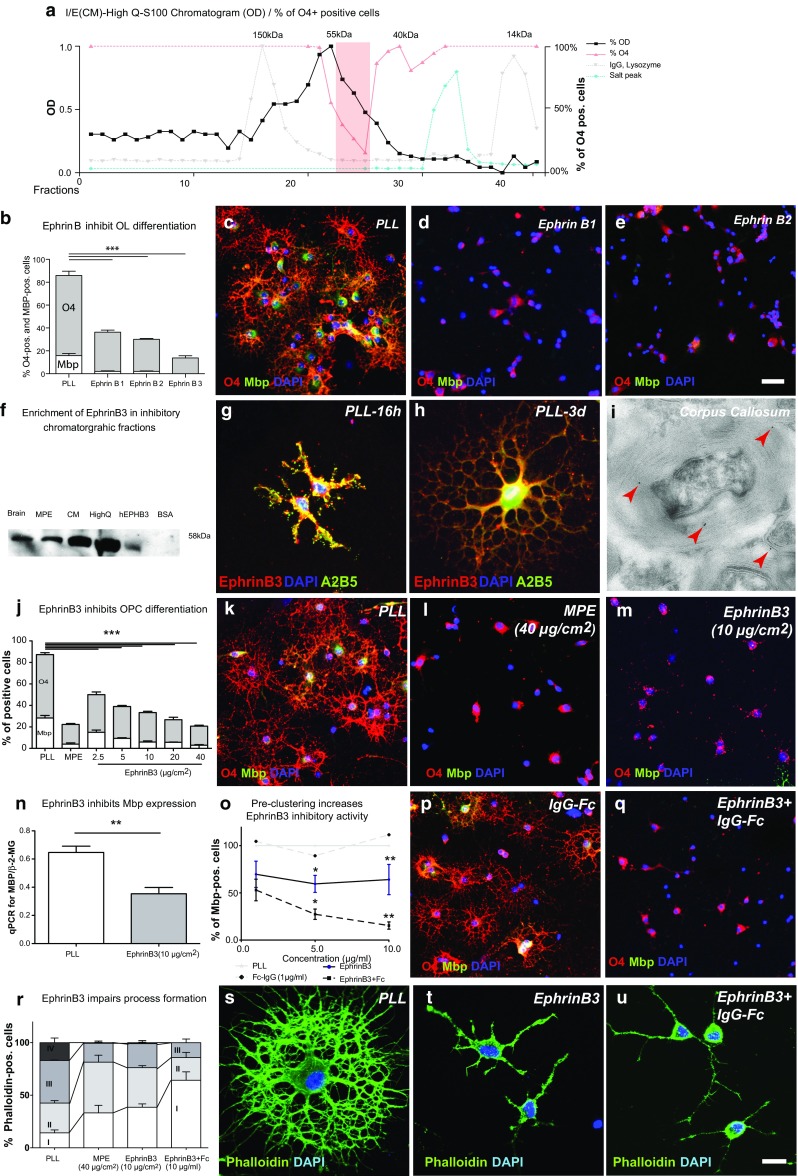Fig. 2.

EphrinB3 is associated with the inhibitory activity of myelin extracts and inhibits OPC differentiation in vitro. a Myelin protein extracts were separated into inhibitory fractions (red line percentage of O4+ cells cultured in the presence of individual fractions) using CM → HiqhQ → Sephadex S100 size-exclusion chromatography (black line S100 chromatogram, grey line IgG and lysozyme peak). Fractions containing proteins with a calculated weight of 51 kDal were associated with the highest inhibitory activity. b Bar graph showing the decrease of O4+ and Mbp+ oligodendrocyte lineage (OL) cells cultured in differentiation medium in the presence of recombinant human EphrinB1, B2, B3 (2-day differentiation, n = 3; ANOVA: O4 ***P < 0.0001, Mbp ***P < 0.0001; Dunnett’s post hoc test: PLL vs. EphrinB1 or EphrinB2 or EphrinB3 at 10 μg/cm2: P < 0.0001). c–e Representative images of cells immunolabelled for O4 (red) and MBP (green) cultured on control substrates (PLL) and EphrinB1, B2 substrates. f Immunoblot demonstrating that CM and subsequent HighQ column chromatography-based enrichment of OPC-differentiation-inhibiting activity results in concordant enrichment of EphrinB3 (brain total brain lysates, BSA bovine serum albumin). g, h EphrinB3 is expressed in immature OPCs (16 h differentiation), throughout to mature oligodendrocyte stages (3-day differentiation). i Electron microscopy immunogold labelled cryo-ultramicrotome sections of murine corpus callosum white matter at 1 months of age demonstrated the presence of EphrinB3 (red arrow) in myelin sheaths in vivo. j–m EphrinB3 inhibited OPC differentiation in a dose-dependent manner (2-day differentiation, n = 3; ANOVA: O4 ***P < 0.0001, Mbp ***P < 0.0001; Dunnett’s post hoc test: PLL vs. MPE or vs. EphrinB3 at 2.5, 5, 10, 20 or 40 μg/cm2: P < 0.0001. n RT-qPCR confirmed reduced expression of Mbp mRNA in the presence of EphrinB3 (n = 3; t test; **P < 0.001). o–q When OPCs were exposed to recombinant EphrinB3-Fc pre-clustered with anti-Fc antibodies mimicking surface-bound EphrinB3, the inhibitory activity was increased (2-day differentiation; n = 3; ANOVA: Mbp ***P < 0.0001; Dunnett’s post hoc test: EphrinB3 vs. EphrinB3 + IgG-Fc at 1, 5 or 10 µg/ml): P < 0.0001. r–u EphrinB3 also induced a reduction in the complexity of OPC processes and a corresponding increase of earlier morphological stages (2-day differentiation; I mono/bipolar, II primary, III secondary, IV membranous branches) (n = 3; ANOVA: P < 0.0001). Error bars ± SEM. Scale bar in c–e, k–m, p–q = 30 μm, in i = 2 μm, in s–u = 20 μm
